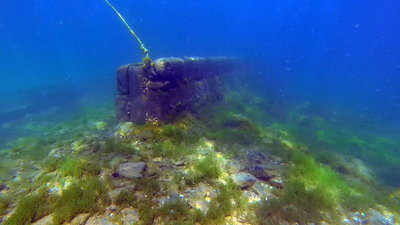by Diver Dan » November 15, 2017, 11:18 am
I also had read that there was some low-level beneficiation going on with some early ores, although not to the extent of today's taconite pellet production.
Some early ores were rock-like, as you can see in the remaining cargo in vessels that didn't reach their destination. I don't have a good close-up, but here is a photo of the cargo of the Schooner Albemarle. The Albemarle loaded in Escanaba for Cleveland in November 1867 and was lost just west of Point Nipigon in the Straits of Mackinac. This is from a video I made of it in July, you can see the pile of rocks of various sizes around the remains of the centerboard. At one point in my video I pick up a small, flat piece of iron that looks like an arrowhead, but reddish and a bit shiny. This entire pile is iron ore, as it stands above a sandy bottom.
- Attachments
-

- Albemarle centerboard and iron ore pile
I also had read that there was some low-level beneficiation going on with some early ores, although not to the extent of today's taconite pellet production.
Some early ores were rock-like, as you can see in the remaining cargo in vessels that didn't reach their destination. I don't have a good close-up, but here is a photo of the cargo of the Schooner Albemarle. The Albemarle loaded in Escanaba for Cleveland in November 1867 and was lost just west of Point Nipigon in the Straits of Mackinac. This is from a video I made of it in July, you can see the pile of rocks of various sizes around the remains of the centerboard. At one point in my video I pick up a small, flat piece of iron that looks like an arrowhead, but reddish and a bit shiny. This entire pile is iron ore, as it stands above a sandy bottom.